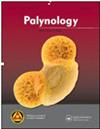The history of palynology in Egypt
IF 1.3
4区 地球科学
Q3 PALEONTOLOGY
引用次数: 0
Abstract
ABSTRACTThis contribution marks the achievements made in the past decades by a group of palynologists. The data generated covers a long-time span from the Precambrian to the Holocene of Egypt. Previously published results are devoted primarily to the study of many exploration wells and outcrop sections. Comprehensive studies were carried out on a range of palynomorph groups including spores and pollen, algae and prasinophytes, dinoflagellates, acritarchs, scolecodonts, chitinozoans, and other miscellaneous forms as well as palynofacies. Particular attention is given to the history of palaeopalynology. This study presents three main phases. The results of the first phase were limited, as the knowledge of palynology in Egypt was poorly known from 1959 until 1979. Between 1980-2000, which represents the second or shaping phase, an intensive study of surface and subsurface material was carried out. The third phase (2000 until now) provides the academic and commercial expansion of palynological research in Egypt, where palynology can have immediate application in petroleum exploration studies.In the first phase, the application of palynology is seriously hampered by the limited extent of the published data. Only 27 works emerged by the end of 1979. A considerable acceleration could be noticed in the second phase when palynological research was established in many national institutions and started to play a considerable role in petroleum exploration. Beyond academia, some of the operating oil companies started to set up palynological labs and staff as part of biostratigraphy teams. These included, for example, GPC, Khalda Petroleum Co. with a focus on the north Western Desert, and GUPCO with a focus on the Gulf of Suez, and most of the results obtained were incorporated with the internal data on the well files. During the period 2000-2009, especially when palynofacies studies were incorporated, the progress and the attitude of palynological research changed. This allowed for a more accurate reconstruction of the depositional process and eventually a paleobiogeographic history mainly for the Cretaceous age, which is an important target for hydrocarbon exploration in Egypt. From 2010 onwards, the number of publications has clearly grown and reached 23 publications in 2020. Such a high pace of development seems to have been at the expense of basic research comprising taxonomy and biostratigraphy, something that might negatively impact the quality of research and also researchers, especially the young ones. The change brought about through this phase by integrating organic geochemistry, sedimentology, and other disciplines may, however, have left a positive impact, principally in terms of international collaborations and expansion of palynology applications beyond the standard academic cluster.Important highlights and outputs, and prospective forthcoming developments and recommendations pertaining to Egyptian palynology generally (and in each phase) are discussed.Key words: palynologyEgypthistoryannotated bibliographyDisclaimerAs a service to authors and researchers we are providing this version of an accepted manuscript (AM). Copyediting, typesetting, and review of the resulting proofs will be undertaken on this manuscript before final publication of the Version of Record (VoR). During production and pre-press, errors may be discovered which could affect the content, and all legal disclaimers that apply to the journal relate to these versions also. Additional informationNotes on contributorsAli Soliman ALI S.A. SOLIMAN graduated in geology from the University of Tanta, Egypt in 1995. In 2000, he finished his MSc studies on the Jurassic palynostratigraphy of the Western Desert, Egypt with Salah El Beialy. In October 2002, he received a Ph.D. scholarship funded by the ÖAD, Austria and he completed his studies on Miocene dinoflagellate cysts from the Gulf of Suez, Egypt in March 2006 under the supervision of W.E. Piller and M.J. Head. Since November 2006, he has been a post-doc embedded in projects funded by the ÖAW and FWF dealing with the taxonomy and stratigraphy of the Miocene dinoflagellates of the Central Paratethys and the ancient Lake Pannon. Currently, Ali is a professor of stratigraphy and palaeontology at the University of Tanta, Egypt.Haytham El Atfy HAYTHAM EL ATFY is an associate professor at Mansoura University (Egypt) from where he received a B.Sc. degree in geology and an M.Sc. in palynology. He received a Ph.D. in geosciences (palynology and organic geochemistry) from Goethe University, Frankfurt (Germany) in 2014, and a PD (Habilitation) from the University of Tübingen (Germany) in 2022. Since 2023, Haytham joined the Palaeobotany Group, Institute of Geology and Palaeontology, University of Münster, Germany. He acquired experience in industrial palynology through work with GUPCO (BP), Egypt. Haytham has been a Research Fellow of the Alexander von Humboldt Foundation at the University of Tübingen (Germany) since 2019. He was recently a visiting scientist at the Senckenberg Research Institute in Germany. His research interests span all aspects of palynology and its applications in dating, palaeoenvironmental and palaeoclimatic reconstructions, and hydrocarbon exploration, particularly of the Mesozoic and Cenozoic and, to a lesser extent, the Palaeozoic. He has more recently become involved in organic geochemistry. He is a member of the AASP—The Palynological Society, the Micropalaeontological Society (TMS), Arbeitskreis für Paläobotanik und Palynologie (APP), and the Palaeontological Society of Egypt (PSE). He received many awards, including the Bernd Rendel Prize from the German Science Foundation (DFG), the Egyptian State Incentive Award, and the First-Class Excellence Concession that the Egyptian president provides.埃及孢粉学的历史
摘要这一贡献标志着孢粉学家在过去几十年中所取得的成就。生成的数据涵盖了从埃及前寒武纪到全新世的很长一段时间。以前发表的成果主要是对许多探井和露头剖面的研究。对一系列孢粉形态类群进行了全面的研究,包括孢子和花粉、藻类和孢粉植物、鞭毛藻、针叶虫、棘孔虫、几丁质动物和其他杂项形式以及孢粉相。特别注意的是古生物学的历史。本研究主要分为三个阶段。第一阶段的结果是有限的,因为从1959年到1979年,埃及的孢粉学知识鲜为人知。1980-2000年是第二阶段,即成形阶段,对表面和地下材料进行了深入的研究。第三阶段(2000年至今)提供了孢粉学研究在埃及的学术和商业扩展,在那里孢粉学可以立即应用于石油勘探研究。在第一阶段,孢粉学的应用受到已发表数据有限的严重阻碍。到1979年底,只出现了27部作品。在第二阶段,当孢粉学研究在许多国家机构中建立起来并开始在石油勘探中发挥相当大的作用时,可以注意到相当大的加速。在学术界之外,一些运营中的石油公司开始建立孢粉实验室和工作人员,作为生物地层学团队的一部分。其中包括GPC、专注于西北沙漠的Khalda Petroleum Co.和专注于苏伊士湾的GUPCO,获得的大部分结果都与井文件的内部数据相结合。2000-2009年,特别是加入孢粉相研究后,孢粉学研究的进展和态度发生了变化。这使得沉积过程得以更准确地重建,并最终确定白垩纪的古生物地理历史,白垩纪是埃及油气勘探的重要目标。从2010年开始,出版物数量明显增加,到2020年达到23篇。如此高的发展速度似乎是以牺牲包括分类学和生物地层学在内的基础研究为代价的,这可能会对研究质量和研究人员,尤其是年轻的研究人员产生负面影响。然而,这一阶段有机地球化学、沉积学和其他学科的整合所带来的变化可能会产生积极的影响,主要是在国际合作和将孢粉学应用扩展到标准学术集群之外。重要的亮点和产出,以及有关埃及孢粉学的未来发展和建议(在每个阶段)进行了讨论。关键词:孢粉学埃及历史注释书目免责声明作为对作者和研究人员的服务,我们提供此版本的已接受手稿(AM)。在最终出版版本记录(VoR)之前,将对该手稿进行编辑、排版和审查。在制作和印前,可能会发现可能影响内容的错误,所有适用于期刊的法律免责声明也与这些版本有关。作者简介:sali Soliman, 1995年毕业于埃及坦塔大学地质学专业。2000年,他与Salah El Beialy一起完成了埃及西部沙漠侏罗纪孢粉地层的硕士学位。2002年10月获奥地利ÖAD博士奖学金,2006年3月在W.E. Piller和M.J. Head的指导下完成了对埃及苏伊士湾中新世鞭毛藻囊肿的研究。自2006年11月起,他一直在ÖAW和FWF资助的项目中担任博士后,研究中央Paratethys和古Pannon湖中新世鞭毛类的分类和地层学。目前,阿里是埃及坦塔大学的地层学和古生物学教授。Haytham El Atfy,埃及曼苏拉大学(Mansoura University)副教授,获得地质学学士学位和孢粉学硕士学位。2014年获得德国法兰克福歌德大学地球科学(孢粉学和有机地球化学)博士学位,2022年获得德国<s:1>宾根大学(Habilitation)博士学位。自2023年起,Haytham加入德国梅恩斯特大学地质与古生物学研究所古植物学小组。他通过在埃及GUPCO (BP)的工作获得了工业孢粉学方面的经验。 Haytham自2019年起担任德国<s:1>宾根大学亚历山大·冯·洪堡基金会研究员。他最近是德国森肯堡研究所的访问科学家。他的研究兴趣涵盖孢粉学的各个方面及其在测年、古环境和古气候重建以及油气勘探方面的应用,特别是中生代和新生代,以及较小程度上的古生代。他最近开始研究有机地球化学。他是aasp -孢粉学会、微古生物学会(TMS)、Arbeitskreis f<e:1> r Paläobotanik und孢粉学会(APP)和埃及古生物学会(PSE)的成员。他获得了许多奖项,包括德国科学基金会(DFG)的Bernd Rendel奖、埃及国家激励奖和埃及总统提供的一流卓越特许权。
本文章由计算机程序翻译,如有差异,请以英文原文为准。
求助全文
约1分钟内获得全文
求助全文
来源期刊

Palynology
地学-古生物学
CiteScore
3.40
自引率
26.70%
发文量
48
审稿时长
>12 weeks
期刊介绍:
Palynology is an international journal, and covers all aspects of the science. We accept papers on both pre-Quaternary and Quaternary palynology and palaeobotany. Contributions on novel uses of palynology, review articles, book reviews, taxonomic studies and papers on methodology are all actively encouraged.
 求助内容:
求助内容: 应助结果提醒方式:
应助结果提醒方式:


